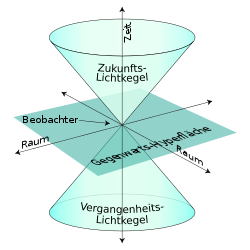Cone of light
In the relativistic physics the designated light cone of an event the set of events that deal with the speed of light to affect or may be affected by the speed of light.

The observer of an event is at the intersection of past and future light cones ( present ).
The light cone is a double cone in the four-dimensional Minkowski space . It consists of
- the backward light cone, which contains exactly the events that took place before ( past , ) and which could have caused the speed of light (see locality and causality ), and
- the forward cone of light, these are the events that take place later than ( future , ) and can have been caused by the speed of light.
definition
Be
- the location and time coordinates of ,
- the coordinates of ,
- the components of the difference vector ,
- the square of the differential distance in flat space-time , which is identical for all observers. The signature used here is . For a signature , analog definitions with the opposite sign apply .
Illuminated difference vector
If the difference vector is light-like :
then in the special theory of relativity lies on the light cone of Exactly the events on the backward or past light cone are currently visible to an observer who is in (without taking into account the expansion of the universe ).
Temporal difference vector
If the difference vector is time-like:
so lies inside the backward or forward light cone of , depending on whether it took place before or after . Then it could be the cause or the effect of , which affects more slowly than light. Events within the backward or past light cone were previously visible to an observer who was in the same place in space as (without taking into account the expansion of the universe).
Spatial difference vector
If the difference vector is space-like:
so lies outside the backward or forward cone of light. The events cannot be about cause and effect, because then a cause would have to act faster than light . Events outside of the backward or past light cone from and in front are not (yet) visible to an observer who is staying in (i.e. they lie behind the event horizon , regardless of the expansion of the universe).
Consequences for the solution of relativistic differential equations
The solution of the inhomogeneous Klein-Gordon equation , valid for bosons , depends only on the earlier initial conditions and the inhomogeneity on the backward light cone from and in its interior.
The solution of the homogeneous Klein-Gordon equation (vanishing mass, corresponds to the wave equation ) only depends on the initial conditions and the inhomogeneity on the backward light cone of , but no longer on the inhomogeneity in its interior. In this case, initial conditions and inhomogeneity only have an effect at the speed of light.
The consequences for solving other fundamental relativistic equations (e.g. the Dirac equation , valid for fermions ) are corresponding.
See also
literature
- Richard Courant , David Hilbert : Methods of Mathematical Physics. Volume 2. Second edition. Springer Verlag, Berlin 1968 ( Heidelberger Taschenbücher 31, ISSN 0073-1684 ).
Web links
- Norbert Dragon: Geometry of the theory of relativity. (PDF; 2.5 MB).

















